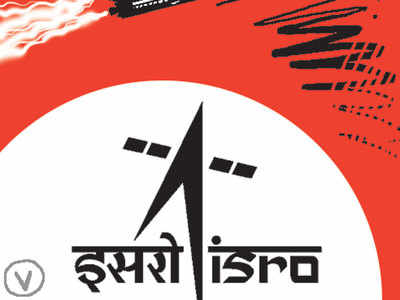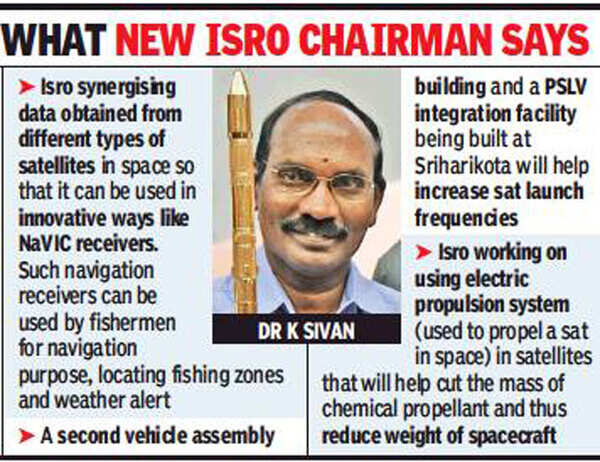- News
- India News
- Space tech being used for 125 govt projects: Isro chief
Trending
This story is from January 29, 2018
Space tech being used for 125 govt projects: Isro chief
Isro is providing space technology to government departments in 125 areas to help them work on projects effectively, new Isro chief Dr K Sivan said. “A second vehicle assembly building will help increase the frequency of launches,” he said.

Key Highlights
- Isro will next launch a communication satellite Gsat-6A next month, Isro chairman said.
- Navigation satellite IRNSS1I will be launched to replace the faulty satellite IRNSS1A, he said.
- The subsequent launches will be of Chandrayaan-2 mission, GSLV Mk III and PSLV C42, he said.
NEW DELHI: Indian Space Research Organisation (Isro) is providing space technology to government departments in 125 areas to help them work on projects effectively and efficiently.
In an exclusive interview with TOI soon after taking over as Isro chairman, Dr Kailasavadivoo Sivan said, “Isro is helping the Centre make the most of space technology for social-welfare and development projects. Explaining how it all started, he said, “Prime Minister Narendra Modi had held a meeting of all ministries some time back where he asked all departments to use the full potential of space technology for the betterment of the common man.In that meeting, 156 areas where identified where Isro could provide space technology solutions to fast-track projects. Out of those 156 areas, Isro is currently training government officials using space technology for 125 such projects like MGNREGA, navigation system and land demarcation plans. Gradually, the number of such areas will be increased.”

The Isro chairman said, “Isro currently has 42 satellites of different types in space. We are trying to synergise the data obtained from communication, navigation and remote sensing satellites so that it can be used in innovative ways for the societal good. For example, we are working on providing NavIC (Navigation with Indian Constellation or desi GPS) receivers to fishermen so that they can access Isro’s navigation system for boat navigation and locating fishing areas on high seas. The NaVIC receiver, along with a mobile app, will also help them track weather and keep themselves updated about any tsunami warning.”
With Isro planning to increase the number of satellites so as to reduce the dearth of communication transponders, Dr Sivan said, “A second vehicle assembly building is coming up at the Sriharikota launch centre and it’s in an advanced stage of being built. Likewise, an additional PSLV integration facility is also being developed at the spaceport. These facilities will help Isro increase the frequency of launches.”
He said, “Isro is also working on the electric propulsion system (being used to propel a satellite in space) so that satellites with such electric propulsion system (EPS) will help reduce their dependence on chemical propellant. With the use of EPS, we can reduce the weight of a satellite. So, a 4-tonne satellite with EPS can do the work of a 6-tonne satellite with same efficiency.” With the development of GSLV Mk III or “fat boy’’ and increase in Isro’s capability to launch heavier satellite of over four tonnes, Dr Sivan said, “Isro will gradually reduce its dependence on the European spaceport for launching heavier satellites. However, a heavier communication satellite, Gsat-11 weighing 5.7-tonne, will be launched from French Guiana this year.”
On the upcoming launches, he said, “Isro will next launch a communication satellite Gsat-6A that will be carried by GSLV F08 next month. Thereafter, navigation satellite IRNSS1I will be launched (that will replace the faulty first navigation satellite IRNSS1A whose three atomic clocks had stopped working in 2016). The subsequent launches will be of Chandrayaan-2 mission, GSLV Mk III and PSLV C42.”
In an exclusive interview with TOI soon after taking over as Isro chairman, Dr Kailasavadivoo Sivan said, “Isro is helping the Centre make the most of space technology for social-welfare and development projects. Explaining how it all started, he said, “Prime Minister Narendra Modi had held a meeting of all ministries some time back where he asked all departments to use the full potential of space technology for the betterment of the common man.In that meeting, 156 areas where identified where Isro could provide space technology solutions to fast-track projects. Out of those 156 areas, Isro is currently training government officials using space technology for 125 such projects like MGNREGA, navigation system and land demarcation plans. Gradually, the number of such areas will be increased.”

The Isro chairman said, “Isro currently has 42 satellites of different types in space. We are trying to synergise the data obtained from communication, navigation and remote sensing satellites so that it can be used in innovative ways for the societal good. For example, we are working on providing NavIC (Navigation with Indian Constellation or desi GPS) receivers to fishermen so that they can access Isro’s navigation system for boat navigation and locating fishing areas on high seas. The NaVIC receiver, along with a mobile app, will also help them track weather and keep themselves updated about any tsunami warning.”
Dr Sivan said, “The agency has already demonstrated the usage of the NaVIC receiver, containing an indigenously-made miniaturised chip, to fishermen in Kerala and Tamil Nadu in the presence of state officials. The fishermen had shown great interest in the NavIC receiver. Thereafter, the agency has requested the industry to mass-produce these receivers so that they can be used by people, including fishermen, for accessing the Indian regional navigation system.”
With Isro planning to increase the number of satellites so as to reduce the dearth of communication transponders, Dr Sivan said, “A second vehicle assembly building is coming up at the Sriharikota launch centre and it’s in an advanced stage of being built. Likewise, an additional PSLV integration facility is also being developed at the spaceport. These facilities will help Isro increase the frequency of launches.”
He said, “Isro is also working on the electric propulsion system (being used to propel a satellite in space) so that satellites with such electric propulsion system (EPS) will help reduce their dependence on chemical propellant. With the use of EPS, we can reduce the weight of a satellite. So, a 4-tonne satellite with EPS can do the work of a 6-tonne satellite with same efficiency.” With the development of GSLV Mk III or “fat boy’’ and increase in Isro’s capability to launch heavier satellite of over four tonnes, Dr Sivan said, “Isro will gradually reduce its dependence on the European spaceport for launching heavier satellites. However, a heavier communication satellite, Gsat-11 weighing 5.7-tonne, will be launched from French Guiana this year.”
On the upcoming launches, he said, “Isro will next launch a communication satellite Gsat-6A that will be carried by GSLV F08 next month. Thereafter, navigation satellite IRNSS1I will be launched (that will replace the faulty first navigation satellite IRNSS1A whose three atomic clocks had stopped working in 2016). The subsequent launches will be of Chandrayaan-2 mission, GSLV Mk III and PSLV C42.”
End of Article
FOLLOW US ON SOCIAL MEDIA










